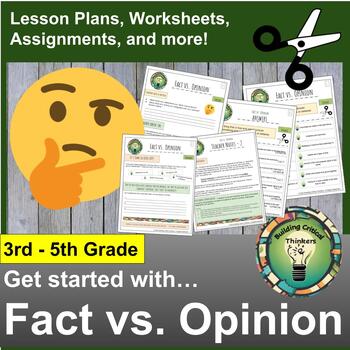They Thought WHAT? - Fact vs. Opinion - Critical Thinking - Elementary
- PDF
Also included in
- Dive into the "Elementary Critical Thinking Adventure Kit," where young minds blossom through engaging cognitive activities. Unlock the door to depth of knowledge, depth and complexity, with lessons for 3rd to 6th grade that explore probability, debunk false memories, and cultivate creative thinkingPrice $10.00Original Price $13.27Save $3.27
Description
They Thought WHAT? Fact vs. Opinion and more! Critical thinking (Elementary)
In search of an engaging lesson plan that sharpens critical thinking skills in your elementary students? Your search ends here! Help your students become critical thinkers, with depth and complexity, not just on April Fools' Day, but every day, developing a habit of careful consideration in how they approach information and decisions.
Our "Fact vs. Opinion" lesson plan is a great addition to your classroom, supply plans, homeschooling, or gifted and extended programs. This lesson isn't just about distinguishing facts from opinions; it challenges students to redefine the concept of "fact" by introducing the intriguing realm of "False Factual Statements."
Key Components:
- Comprehensive lesson plan
- Clearly defined learning goals
- Seven carefully designed worksheets guiding students through the distinctions between facts and opinions, including handling false factual statements.
This lesson kicks off with elementary students delving into the world of facts and opinions. Through a hands-on activity, they cut out and sort 14 statements into "fact" and "opinion", fostering collaboration with classmates and sparking discussions. The journey continues as students write their own lists of facts and opinions, reinforcing their understanding of the distinction.
Time to Level Up! Things take a twist as students encounter factual-sounding statements that are, in fact, FALSE—cue cognitive dissonance! This revelation prompts a nuanced exploration, leading students to redefine "fact" into two sub-groups: "True Factual Statements" and "False Factual Statements." Further engagement involves cutting and sorting additional statements based on this principle.
Finally, students apply their newfound knowledge by analyzing a paragraph to identify opinions, true factual statements, and false factual statements. This lesson's flexibility allows it to be completed in one session or split into smaller chunks. It's also suitable for supply teachers, stations (with support), or enrichment with gifted students.
Included in this comprehensive package are seven carefully designed worksheets, expertly guiding students through the intricacies of "Fact vs. Opinion," including how to handle false factual statements. Answers for everything (except the paragraph analysis, as it's straightforward) are provided.
The primary learning goals are to enable students to distinguish between facts and opinions, introduce the concept of false factual statements, and foster critical thinking skills to analyze and differentiate information.
We believe this lesson plan will not only enrich your teaching resources but will also empower your elementary students to navigate the complexities of information with discernment and clarity.
Building Critical Thinkers is a resource designed to help educators in effectively teaching critical thinking skills to their students. While the importance of these skills has long been recognized, our education systems have not adequately focused on providing explicit training for educators in this regard.
Sign up here to get an amazing free full lesson on Confirmation Bias and the Full Moon! This store is just getting started, so check back soon for a bunch of new Critical Thinking Lessons for your students!
By purchasing this content, you have the right to use this in your own practice with your students. Please do not share with other educators in your schools or district, or post online. We hope you understand the reasons for this - we’d love to be able to continue to produce quality content in the future. All images found within are used with the appropriate rights. This material cannot be sold or distributed in any way that generates income. Some resources found on “Building Critical Thinkers” may be editable, and some may not be. Please respect that.
© 2023 Building Critical Thinkers. All Rights Reserved.






